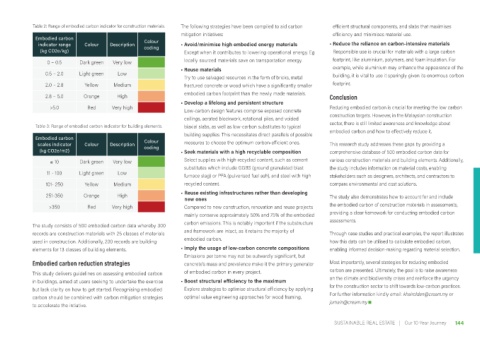Page 155 - GreenRE_Sustainable Real Estate Book
P. 155
Table 2: Range of embodied carbon indicator for construction materials. The following strategies have been compiled to aid carbon efficient structural components, and slabs that maximises
mitigation initiatives: efficiency and minimises material use.
Embodied carbon
indicator range Colour Description Colour • Avoid/minimise high embodied energy materials • Reduce the reliance on carbon-intensive materials
(kg CO2e/kg) coding Except when it contributes to lowering operational energy. Eg Responsible use is crucial for materials with a large carbon
0 – 0.5 Dark green Very low locally sourced materials save on transportation energy. footprint, like aluminium, polymers, and foam insulation. For
• Reuse materials example, while aluminium may enhance the appearance of the
0.5 – 2.0 Light green Low
Try to use salvaged resources in the form of bricks, metal building, it is vital to use it sparingly given its enormous carbon
2.0 – 2.8 Yellow Medium fractured concrete or wood which have a significantly smaller footprint.
embodied carbon footprint than the newly made materials.
2.8 – 5.0 Orange High Conclusion
• Develop a lifelong and persistent structure
>5.0 Red Very high Reducing embodied carbon is crucial for meeting the low carbon
Low-carbon design features comprise exposed concrete
ceilings, aerated blockwork, rotational piles, and voided construction targets. However, in the Malaysian construction
Table 3: Range of embodied carbon indicator for building elements. biaxial slabs, as well as low-carbon substitutes to typical sector, there is still limited awareness and knowledge about
building supplies. This necessitates direct parallels of possible embodied carbon and how to effectively reduce it.
Embodied carbon Colour
scales indicator Colour Description coding measures to choose the optimum carbon-efficient ones. This research study addresses these gaps by providing a
(kg CO2e/m2) • Seek materials with a high recyclable composition comprehensive database of 500 embodied carbon data for
≤ 10 Dark green Very low Select supplies with high-recycled content, such as cement various construction materials and building elements. Additionally,
substitutes which include GGBS (ground granulated blast the study includes information on material costs, enabling
11 - 100 Light green Low furnace slag) or PFA (pulverised fuel ash), and steel with high stakeholders such as designers, architects, and contractors to
101- 250 Yellow Medium recycled content. compare environmental and cost solutions.
251-350 Orange High • Reuse existing infrastructures rather than developing The study also demonstrates how to account for and include
new ones
>350 Red Very high Compared to new construction, renovation and reuse projects the embodied carbon of construction materials in assessments,
mainly conserve approximately 50% and 75% of the embodied providing a clear framework for conducting embodied carbon
The study consists of 500 embodied carbon data whereby 300 carbon emissions. This is notably important if the substructure assessments.
records are construction materials with 25 classes of materials and framework are intact, as it retains the majority of Through case studies and practical examples, the report illustrates
used in construction. Additionally, 200 records are building embodied carbon. how this data can be utilised to calculate embodied carbon,
elements for 13 classes of building elements. • Imply the usage of low-carbon concrete compositions enabling informed decision-making regarding material selection.
Emissions per tonne may not be outwardly significant, but
Embodied carbon reduction strategies concrete’s mass and prevalence make it the primary generator Most importantly, several strategies for reducing embodied
This study delivers guidelines on assessing embodied carbon of embodied carbon in every project. carbon are presented. Ultimately, the goal is to raise awareness
in buildings, aimed at users seeking to undertake the exercise • Boost structural efficiency to the maximum on the climate and biodiversity crises and reinforce the urgency
but lack clarity on how to get started. Recognising embodied Explore strategies to optimise structural efficiency by applying for the construction sector to shift towards low-carbon practices.
carbon should be combined with carbon mitigation strategies optimal value engineering approaches for wood framing, For further information kindly email: khairolden@cream.my or
to accelerate the intiative. jumain@cream.my
SUSTAINABLE REAL ESTATE | Our 10-Year Journey 144

